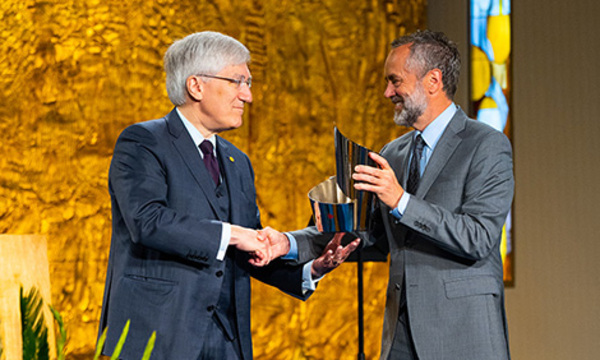When we moved into our house several years ago the backyard was a mess. The previous owners had large dogs, which had torn up whatever grass had survived from the late â50s, when the neighborhood was built. And there was that ugly wall separating us from the folks next door. One of our first outdoor projects involved building trellises next to this wall and planting vines that would, according to our plan, climb up and hide that eyesore.
Well, itâs been 20 years since I built those trellises, and I hadnât given them much thought until about a year ago. Wandering through Rolaneâs delightful collection of flowers and plants, I noticed that one section of my handiwork was rotting and falling apart. But the vine was doing well. In fact, it was now holding up the trellis! That made me think about the nature of the trellis, and how it reflects the realities of what we do in ministry. Let me elaborate.
Trellises provide strength and support. The flimsy little vines we planted so long ago were at first not able to stand on their own. We tied fragile limbs to the latticework, which provided them safety as they grew thick and strong. In the same way, parents are a trellis to their children and pastoral leaders to the saints. As we struggle to establish our families and ministries, we need the steadfast support of others stronger than ourselves.
When the children of Israel were in the earliest days of the exodus, their sojourn would have been short-lived without the strong hand of Moses, whose true strength, of course, came from the Lord. Years after the powerful events of that journey, the Psalmist would praise God for his greatness and provision by concluding, âYou led your people like a flock by the hand of Moses and Aaronâ (Ps. 77:20). As an infant nation, Israel was blessed through the strength and support of faithful servants as they journeyed to the Promised Land.
Trellises guide and direct growth. Vines will go everywhere and nowhere if not given a route to follow. When we look at our children, or at the people God has given us in our ministries, where do we want them to go? In a way, we serve as their trellis by the things we say and live for. I think of Paulâs letter to the Philippians when he writes, âI want to know Christ and the power of his resurrection and the fellowship of sharing in his sufferings, becoming like him in his death, and so, somehow, to attain to the resurrection from the deadâ (Phil. 3:10-11). Christian leaders aspire to all kinds of things today â innovative ministries, large crowds, top-notch facilities â but our ultimate goal must always be Christ, and him alone. Our lives should point those around us in his direction.
Trellises supply a pattern for growth. Our goal for the vines on our trellis was âup,â but we were also concerned about âshape.â As we watch our grown children raise their children, we wonder what kind of people our grandkids will become. What kind of character will they possess? Itâs sobering to realize that we have a part to play, as do their parents. Paul was able to say to the Philippians, âJoin with others in following my example, brothers, and take note of those who live according to the pattern we gave youâ (3:17). And again, to the Corinthians he wrote, âFollow my example, as I follow the example of Christâ (1 Cor. 11:1).
Paul was not asking his beloved brethren to be clones. They were all uniquely made and gifted, just as he was. No, he desired that they exhibit the fruit of the Spirit through lives of daily obedience in keeping with their position as saints of the Lord. The vine that follows the trellisâ pattern does not look exactly like the host, but does reflect its general form. Like it or not, we are providing a template upon which others measure their life of faith. We should want that pattern to be reflective of Jesus Christ.
Trellises eventually disintegrate. Even though the trellises in my backyard were well-built out of good materials, the ravages of time and weather have left many of them significantly compromised. They are falling apart, just as we are all falling apart. Our days on this earth are limited. As Godâs trellises, we have choices to make. Will we, as we depend on the Lord, provide strength and support to those around us? Will we point others to Jesus Christ? And will we live our lives so that others can follow our pattern of obedience and faithfulness to God?
May we all seek to be faithful as Godâs trellises and leave behind a beautiful tapestry of his handiwork in the lives of others.
 șÚĘźÊÓÆ”
șÚĘźÊÓÆ”
.jpg)

